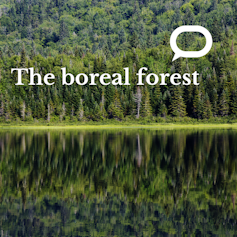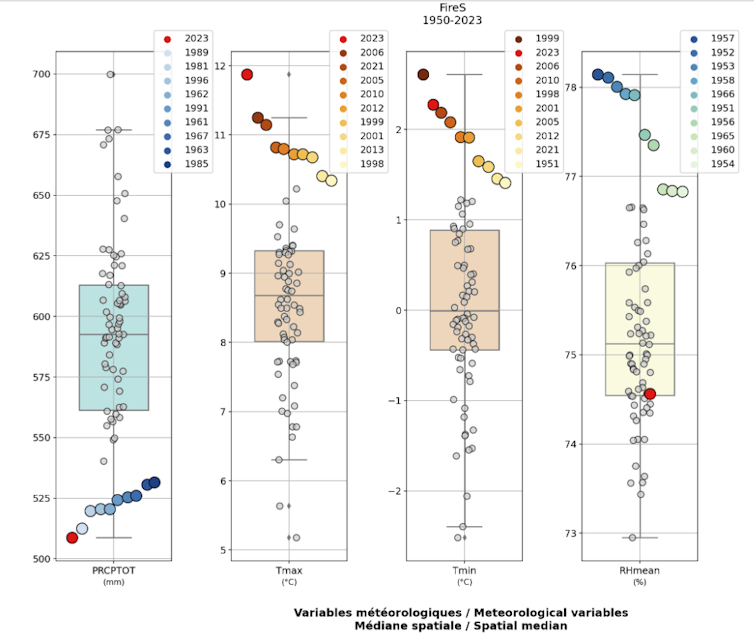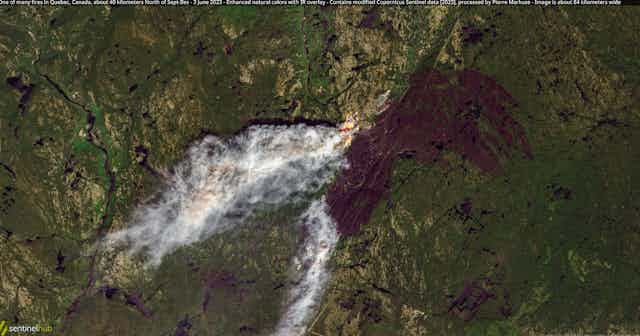After a summer of exceptional wildfires, the return of cooler temperatures and snowy conditions will provide Québec’s forests a brief respite.
But how long will it last? Are events like these destined to become more frequent?

This article is part of La Conversation Canada’s series The boreal forest: A thousand secrets, a thousand dangers
La Conversation Canada invites you to take a virtual walk in the heart of the boreal forest. In this series, our experts focus on management and sustainable development issues, natural disturbances, the ecology of terrestrial wildlife and aquatic ecosystems, northern agriculture and the cultural and economic importance of the boreal forest for Indigenous peoples. We hope you have a pleasant — and informative — walk through the forest!
As experts in disturbance dynamics occurring in the boreal environment, we are assessing the fires that occurred in Québec in 2023 to provide insights into their causes and consequences.
Millions of hectares affected
According to Québec’s Société de protection des forêts contre le feu (Society for the protection of forests against fire, SOPFEU), nearly 700 fires have burned approximately 5.1 million hectares (equivalent to the territory size of Costa Rica), both north and south of the northern forest limit designated by the province — or the boundary that separates northern Québec forests from the southern forests, where logging is conducted.
At the beginning of October, fifteen of the fires that had started in the summer were still active in western Québec. Three of them, although contained, had burned a total of almost 700,000 hectares within the intensive protection zone, where the SOPFEU systematically fights all fires.
In the northern zone, twelve fires were still under surveillance, some not exceeding 20 hectares, others covering more than a million hectares. Out of the total area burned in 2023 in Québec, three-quarters (3.8 million hectares) were in the northern zone. South of the 50th parallel, within the intensive protection zone, approximately 1.4 million hectares burned, which is more than 80 times the annual average of the past ten years.

When we compare the 2023 fire season to datasets available since the 1970s, it becomes quite clear that this year was unusual compared to recent decades. Yet, although these fires are impressive and difficult to contain, they are still within the range of “natural variability” observed in previous centuries.
Several studies have shown that particularly intense fire cycles were common in Québec during the period from 1910-1920. These were even more common in the 18th and 19th centuries when warm and dry climatic conditions were particularly conducive to forest fires.

Exceptional weather conditions
Like historic forest fires, fire outbreaks in Québec in 2023 were fuelled by intense weather conditions. Starting in June, after an already dry month of May, a significant increase in fires was observed in the intensive protection zone. The northern zone was affected throughout the three summer months.
These fires were mainly started by lightning. Their spread was then exacerbated by low precipitation and abnormally high temperatures. Temperatures exceeded the 1981-2010 average for the month of June by 2.3°C, setting a record for the warmest June recorded in Québec in at least a hundred years.
These exceptional weather conditions were partly influenced by the El Niño phenomenon, a cyclical warming of the Pacific Ocean known for its impact on terrestrial weather conditions. The trend continued into July, which witnessed exceptionally high average temperatures, well above normal (+2.7°C).

Multiple consequences
The simultaneous outbreak of numerous fires and their rapid spread have had multiple effects on wildlife, forests, the climate, and human populations.
The fires have altered the structure and composition of vegetation, causing disruption to wildlife habitats as well as displacement and mortality among animals. As a result, the hunting, fishing and harvesting territories of Indigenous communities have been affected.
In addition to representing a direct threat to public safety, the smoke from the fires caused respiratory problems, leading to the evacuation of thousands of people in several regions of Québec. The deterioration in air quality was felt not only across Canada and the United States, but also as far as Europe. Fortunately, evacuations were carried out in time, and casualties were avoided. However, there was some material damage.
In terms of their impact on the climate, large fires released several megatons of carbon dioxide stored in trees and soils, contributing to an increase in atmospheric concentrations of greenhouse gases (CO2, CH4).
While the fires have had significant consequences, they can sometimes be beneficial for certain organisms. We can consider tree species like jack pine, which depend on fires for regeneration, and numerous animal species that thrive in burned forests.
What can we expect in the future?
Québec’s forests have been burning and regenerating cyclically for millennia. However, it is imperative to recognize that these cycles can evolve over time.
The 2023 fire season highlights the urgency of preparing for significant changes in disturbance dynamics, including the possibility of such events recurring more frequently.
As climate change progresses, periods of drought could become more frequent if precipitation fails to compensate for rising temperatures, as observed in the 20th century.
This combination of factors increases the likelihood of an increase in the number, size, and intensity of wildfires.
Such changes threaten the natural regeneration of forests and could lead to the formation of treeless areas, victims of too frequent fires for vegetation to have time to regenerate.
These conditions could also be exacerbated by the continued expansion of logging. Preliminary analyses have shown that more than 300,000 hectares of forests burned in 2023 may not regenerate, mainly due to the effects of logging in recent decades.
The consequences of major forest fires highlight the climate challenges we face. They demonstrate the need to develop mitigation and adaptation measures aimed at protecting vulnerable forest ecosystems and their inhabitants.
It is therefore imperative to learn lessons from the 2023 fire season to strengthen the resilience of forests and communities to climate change and limit damages caused by fires. This involves reducing risk, protecting the most vulnerable areas, and raising awareness among local populations.


